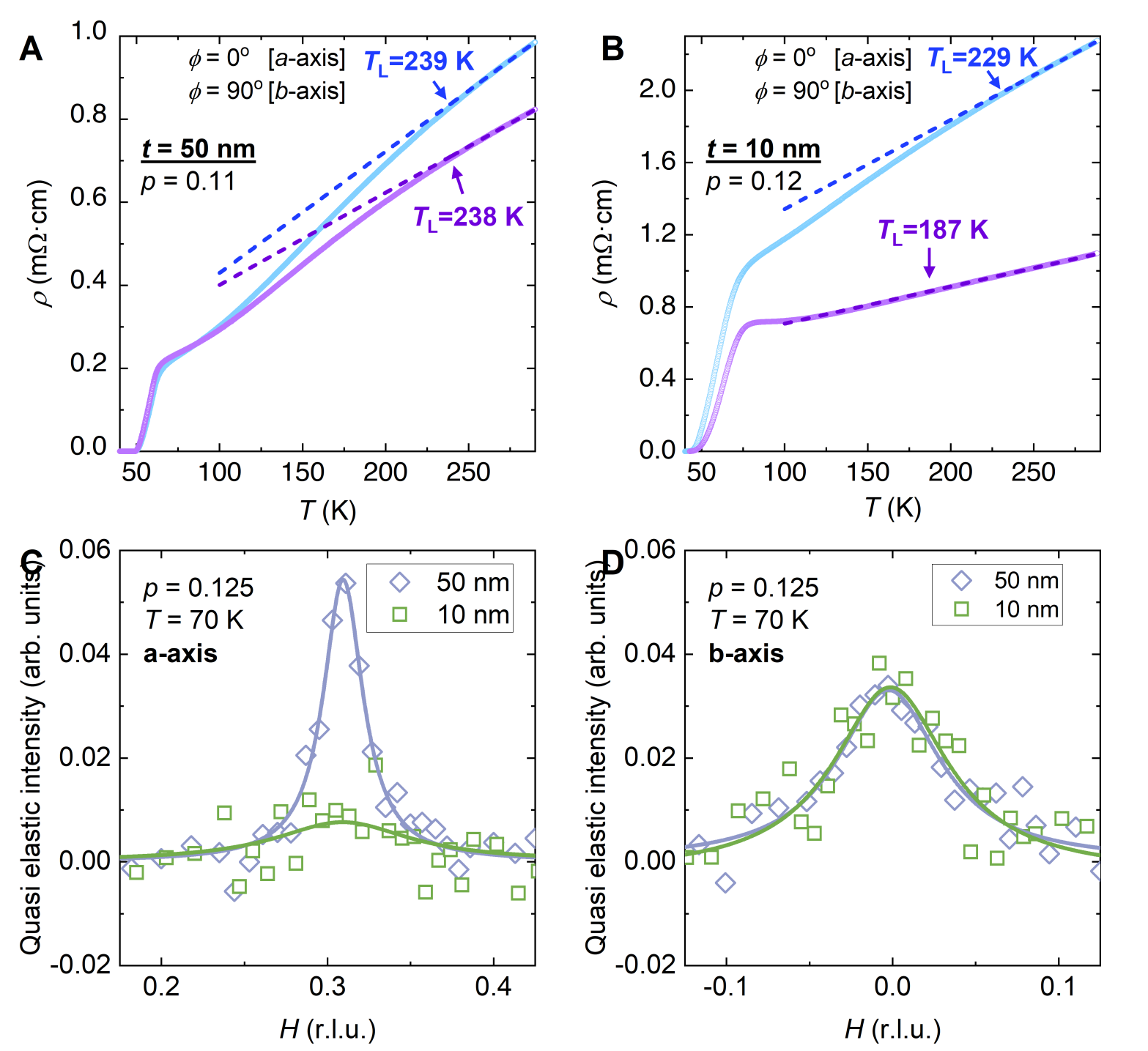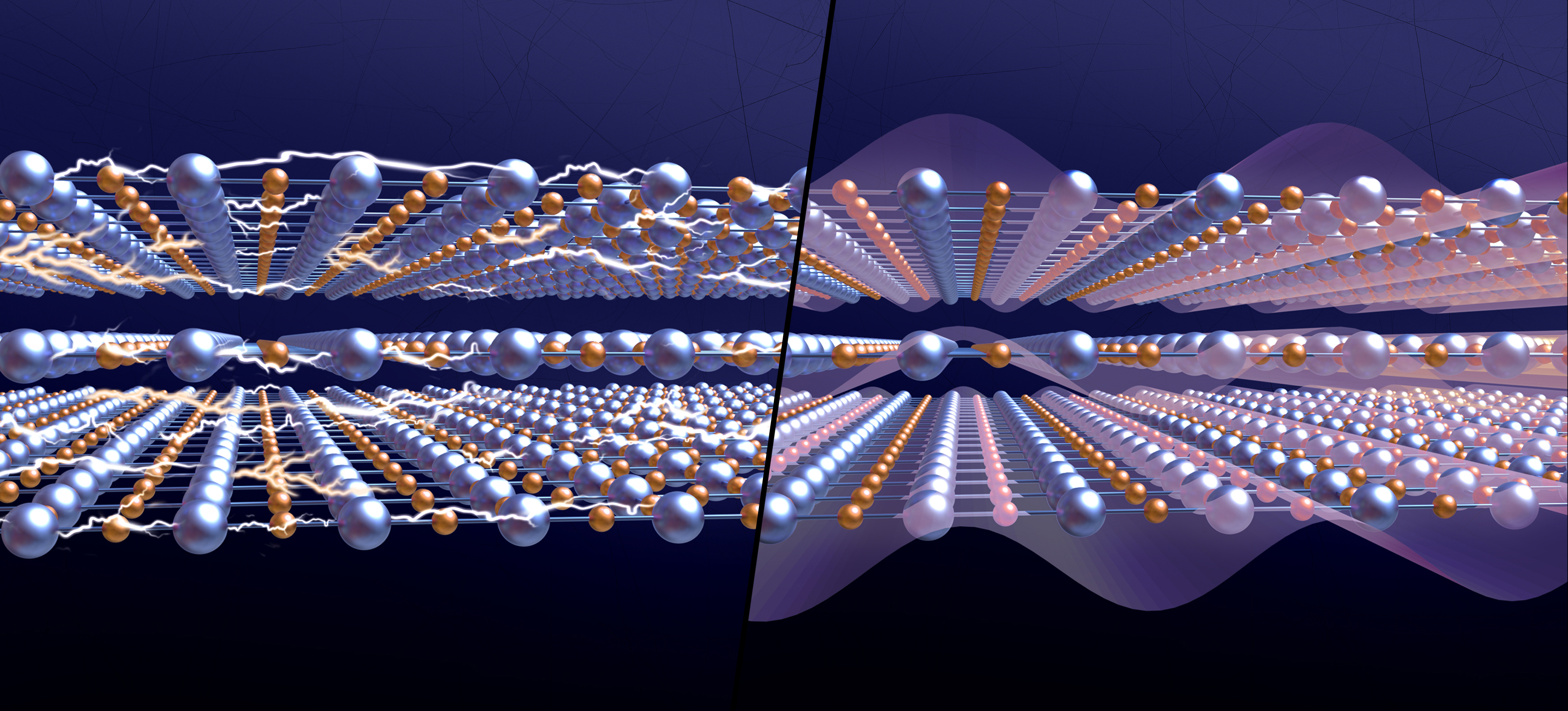- Home
- News
- Spotlight on Science
- Making the ‘strange...
Making the ‘strange metal’ in high-critical-temperature superconductors even stranger
09-12-2021
Mechanical strain in ultrathin films sheds new light on the understanding of high-temperature superconductors (HTS). Transport and RIXS measurements on beamline ID32 are combined to show that strain can be used to modify the material ground state and suppress charge density waves, which in turn restores the “strange metal” behaviour in a large portion of the HTS phase diagram.
Share
Cuprate high-critical-temperature superconductors (HTS) belong to a class of materials where strong electron-electron correlations play a fundamental role [1]. The “strange metal” phase of these superconductors is one of the most striking manifestations of the strong correlations. At optimal doping, this phase manifests as a linear temperature-dependence of the resistivity that persists to the lowest T when superconductivity is suppressed. This behaviour is fundamentally different from that observed in more conventional metals, where a linear T-dependence of the resistivity is found only at high temperatures where phonon scattering dominates the transport.
In cuprates, the T-linear resistivity is lost for doping below the optimal doping. Here, the deviation from T-linear behaviour happens at temperatures close to T*, known as the pseudogap temperature, where states are missing at the Fermi energy. In the pseudogap region, the HTS phase diagram also hosts a plethora of intertwined symmetry-breaking ordering phenomena [1]; charge density wave (CDW) order [2] is the most prominent one. The association between the departure from the T-linear resistivity and the occurrence of the pseudogap has long been speculated. However, there is no consensus on the physics at play, nor on the causality hierarchy among pseudogap, local orders and strange metal phenomenology [3]. The challenge is to disentangle the various possible mechanisms leading to the breakdown of the T-linear resistivity. One way to address this challenge is to tune the local properties of underdoped high-temperature superconductors.
To tune the ground state in thin films of the cuprate material YBa2Cu3O7–δ (YBCO), the geometric modification of the unit cell occurring under the strong strain induced by the substrate when the film thickness is reduced from 50 down to 10 nm was utilised. In particular, X-ray diffraction characterisation showed that – by squeezing the thickness – the total volume of the cell is unchanged, while the b-axis expands significantly. Such cell deformation implies an increase of orthorhombicity and, indirectly, the occurrence of a nematic state, which dramatically modifies the Fermi surfaces of YBCO and the CDW order. To investigate the transport and possibly determine its connection with the charge density wave order, resistivity vs. temperature ρ(T) and resonant inelastic X-ray scattering (RIXS) spectra were measured at beamline ID32 along both in-plane (a and b) directions of the 50- and 10-nm-thick films.

Fig. 1: a) ρ(T) of two devices, oriented along the a- and b- axis directions, patterned on a 50-nm-thick underdoped film. TL is the temperature where ρ deviates by 1% from the linear fit (dashed line). b) Same as panel (a), but on a 10-nm-thick underdoped film. c-d) H-scans determined by RIXS for both samples, respectively along the a- and the b- axis directions.
On the 50-nm-thick films, both the ρ(T) (Figure 1a) and the CDW, detected by RIXS (pink data in Figure 1c-d), are as in detwinned single crystals: on one side, the T-linear resistivity (i.e., the most significant signature of the HTS in the normal state) occurs in a range that is identical along both a- and b-axis directions, and in agreement with the opening of a pseudogap at the temperature T*; on the other side, the CDW is bidirectional. However, this changed dramatically when the 10-nm-thick films were investigated. Here, the T-linear resistivity was restored almost down to the superconducting critical temperature Tc along one direction (Figure 1b), while the CDW amplitude became unidirectional (blue data in Figure 1c-d). The strain-induced disappearance of the CDW restores the strange metal state, which can therefore expand in a much larger temperature range.

Fig. 2: Left: The copper-oxide planes of YBCO are presented in the strange metal phase, where the strong interaction between electrons, the 'quantum entanglement', is illustrated in terms of lightning. Right: The same planes are presented when CDW appear. Here, the symmetry of the system is reduced by the appearance of these local modulations of the conducting electrons, which cause the suppression of the strange metal phase. Illustration: Y. Strandqvist.
This observation points towards an intimate connection between the onset of CDW and the departure from the T-linear resistivity in underdoped cuprates (Figure 2) – a link that was missing until now and that also challenges the relation between charge order and pseudogap. This experiment also illustrates the potentiality of strain control to manipulate the ground state of these quantum materials.
Principal publication and authors
Restored strange metal phase through suppression of charge density waves in underdoped YBa2Cu3O7–δ, E. Wahlberg (a), R. Arpaia (a,b), G. Seibold (c), M. Rossi (b), R. Fumagalli (b), E. Trabaldo (a), N.B. Brookes (d), L. Braicovich (b,d), S. Caprara (e,f), U. Gran (a), G. Ghiringhelli (b,g), T. Bauch (a), F. Lombardi (a), Science 373, 1506 (2021); https://doi.org/10.1126/science.abc8372
(a) Chalmers University, Göteborg (Sweden)
(b) Politecnico di Milano (Italy)
(c) BTU Cottbus-Senftenberg (Germany)
(d) ESRF
(e) Università La Sapienza (Italy)
(f) CNR-ISC, Roma (Italy)
(g) CNR-SPIN, Milano (Italy)
References
[1] B. Keimer et al., Nature 518, 179 (2015).
[2] G. Ghiringhelli et al., Science 337, 821 (2012).
[3] E. Fradkin et al., Rev. Mod. Phys. 87, 457 (2015).



